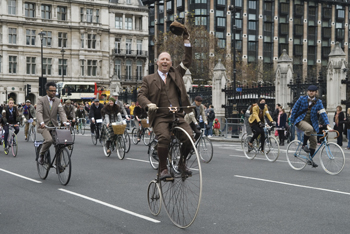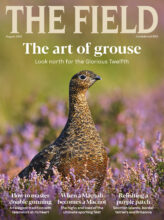
Pip, pip! I say old chap, what splendidly spiffing handlebars.” Behind me, two gentlemen are standing by a vintage bicycle. I glance at the handlebars. Spiffing? Perhaps not, but one of the fellows is sporting a most magnificent upward-curved moustache. I’m on The Tweed Run, where meticulously preened facial hair and archaic terminology are entirely appropriate.

During this “metropolitan bicycle ride with a bit of style”, participants adorned in tweed ride their bicycles, most of which are vintage, in convoy through the centre of London on a route that is a fiercely guarded secret. This year, there are penny farthings, Hetchins, Pashleys, Bromptons
– and “Boris” bikes. The group is kept in motion by marshalls who ride a short distance ahead and stop the traffic whenever necessary. Consequently, the cyclists cause little disruption and most of the drivers who do get held up enjoy the spectacle and so don’t mind the delay. Lycra is banned and the only modern cycling equipment spotted during the day belongs to the St John Ambulance cyclists who, with their high-vis clothing, protective helmets, gloves and radios provide quite a contrast to the acres of tweed. As one rider remarks, “What a delight – no safety briefing nor a police officer or piece of Lycra in sight.”
The Tweed Run starts at Prince’s Gardens in South Kensington, where the cyclists lock up their bicycles to go for the team photo on the steps of the Royal Albert Hall. Before we leave, the lady I am speaking to keeps looking over my shoulder. “I’m just admiring that man’s bottom, or his D-lock, to be more precise.” When she sees how high my eyebrows have risen she hurriedly explains that she has a D-lock to keep her bike secure but has never thought of attaching it to her belt as the man has done, as a way of carrying something so cumbersome. I pretend to believe her.

On the way to the hall I watch the “Runners” doffing their caps at the City of Westminster traffic warden, who has probably never been treated so courteously. Whether or not it will prevent him from slapping a ticket on the organiser’s vintage car, which is parked on double yellow lines, is not disclosed. Once the photograph has been taken we return to the bicycles, serenaded by musicians playing from two rickshaws crammed with instruments and music stands. Before long, with horns tooting, bells tringing and cries of “Tally ho!”, The Tweed Run begins.
The couple behind this event are Jacqui Shannon and Ted Young-Ing, who met through a website for London cyclists and then became further acquainted through business. But it was only after Ted returned from a work trip to Edinburgh, during which he had bought some tweed plus-fours, that the concept of a Tweed Run was formulated.
Having found he didn’t have an event at which to wear them, he asked on the website whether anyone wanted to dress up in tweed and go for a cycle. A few weeks later, Young-Ing and Shannon and a few others met for breakfast near to the agreed starting point. When they rounded the corner a sea of tweed met them; nearly 300 cyclists had turned up. That was in 2009, and the run’s popularity – it is held in aid of World Bicycle Relief – has since soared. Entry to this year’s event was through a lottery system as the 500 places available (restricted by an agreement with the City) are coveted by those who feel the need for tweed.

Following its success in London the organisers have taken the run to New York and Florence, with the mayor of the latter leading the way while directing the police to block traffic for the cyclists. “No matter which city we take The Tweed Run to, people come. It’s fun, stylish and unique,” Shannon tells me.
Entrants have previously come from as far away as Japan and Australia. This year one lady from South Korea booked her flight especially for The Tweed Run without knowing whether she had got a place or not. She hadn’t. Felix Kemper, from Belgium, was luckier. He won the last pair of tickets (a few places were available through competitions) and got up at 3am to drive from Ghent to London to take part on his own brand of bike. He was planning to drive back home in time for work the following morning.
The Cordings VIP tickets were won by Sophie Hunt, who bought a Pashley bike three days beforehand. But her luck appeared to have run out before the start, when she spotted a puncture. Surrounded by cycling enthusiasts and Pashley specialists, it was fixed in a jiffy. She tells me that the £540 bicycle is a “stellar investment, such a slick machine and real statement piece. More of a fashion accessory, some might say.” Indeed, her tights complement the powder blue of her bicycle and, with the addition of her grandfather’s Second World War British Army desert goggles, she bears a striking resemblance to Penelope Pitstop. Her brother, Charles, wears his father’s brogues from school and his grand-father’s three-piece tailor-made suit, as well as a similar pair of goggles.

They are not the only cyclists who have put such effort into their outfits. Jonathan Fulford, Master of a beagle pack, is dressed in his Cordings beagling waistcoat, Purdey shooting breeks, Holland & Holland jacket and shoes, and Pakeman Catto & Carter cravat and cap; he looks like an advertisement for British tailoring. He has even accessorised with a game-bag made from a cleverly converted pair of trousers. The look is finished with his Pashley deli bike complete with bread sticks, some of which, he tells me later, were used in an impromptu game of bicycle polo while on the ride past St Paul’s. He confides that he has spent the previous week “quivering with excitement, like a spaniel on a shoot day. There are only two reasons for this country mouse to go to town: a countryside rally or The Tweed Run.”

Martin Young, another tweed fanatic and a Tweed Run veteran, confesses that the Harris tweed outfit he is sporting was purchased especially for the event, though tweed is a staple in his wardrobe. Whenever he goes cycling in his village in Yorkshire he dons a checked shirt, tie and plus-fours as he finds traditional fabrics more breathable. Which makes one memorable incident during the day even more poignant. “Perhaps one of my favourite moments was sharing the mirror in the gents of a public house with Graham Coxon [lead guitarist of the band Blur, who was judging Most Dapper Chap and Most Dashing Dame] discussing the knotting of ties. Bizarre, yet quite marvellous – this could only happen on The Tweed Run.”
Noticing Young’s facial hair, I ask whether he has grown it especially for the Best Moustache competition that Murdock London is sponsoring. No, he grew mutton chops for the first Tweed Run in 2009 and has kept a moustache of one style or another ever since. Looking around there is every conceivable style of upper lip blanket, to use the sponsor’s term. However, when my photographer companion introduces me to the lady with the moustache, I am rather taken aback. After berating him for being so personal it is with relief that I realise it is false.
Teresa Stokes is raring to go in her Cordings socks, her great-aunt’s riding breeches from the Forties and a Harris tweed jacket and hat. She has a connection, she is eager to inform me: her great-uncle, Sir Geoffrey Harmsworth, was a former owner of The Field. She is regretting leaving her Field hip-flask, which she received as a subscription gift a few years ago, at home on such a chilly morning, but when I see her again at the tea stop she looks as though the pedalling has warmed her up.
The gardens of the Imperial War Museum are the location for the halfway refreshment break. Tea and cakes are available as well as the chance to ease saddle-sore posteriors. While most people prop their bikes up to go and stretch their legs, one rider, Simon Harcourt, is struggling to keep hold of his while simultaneously balancing a teacup and saucer and a cupcake. After making a few enquiries, I understand his reluctance to let go: he has had the bike custom built for the run. As director of a leather interiors company and after telling several clients that he could wrap anything in leather, Harcourt felt he had to prove it. The result is this beautiful bicycle, labelled “The Brogue”, which is clothed in laser-cut leather. Being unique and precisely crafted, it has an estimated value of £7,000.
When Harcourt’s friend Nicholas James of the eponymous jewellery store hears about it he takes it to another level, adding “essential riding equipment” – four carats of chocolate diamonds pavé set in the sterling silver handlebar ends and a pair of diamond-set Conway buckles on the rear saddle-bag. The price shoots up to an eye-watering £25,000.
Had I been in charge of such a valuable bicycle for its first outing I wouldn’t have dared do anything but concentrate on not crashing. But, once underway, Harcourt relaxes and even finds time for a bit of tourist teasing along the way. When an American asks him what the event is, he replies that it is The Tweed Run. The American asks whether it occurs frequently. “Oh yes,” Harcourt as-sures him. “Every Sunday, and we are off to Stonehenge after this.” The gullible tourist is still nodding as Harcourt pedals away.

Another rider comments that going past Buckingham Palace and seeing all the tourists turn their backs on it to gaze at the cyclists is the best moment of the day. But perhaps the observation that best sums up what a spec-tacle they and their bicycles make is from Lea Reynolds: “My favourite part was when a man coming out of a shop with a bottle of cider clocked us riding past, looked at his bottle, then shook his head.”
The event finishes with prize-giving before the whisky sodas and Scotch eggs are brought out for those who need a little fortification after five hours in the saddle. For those who haven’t found the cycling too tiring, there’s a swing band. Toasts are made, perhaps including one for the couple for whom The Tweed Run has served as the backdrop to the beginning of the rest of their lives – they got engaged at the tea stop. No doubt at their wedding the bride will look sweet upon the seat of a bicycle made for two.




